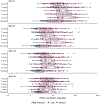Associations between prenatal and childhood PBDE exposure and early adolescent visual, verbal and working memory
- PMID: 29787900
- PMCID: PMC6460908
- DOI: 10.1016/j.envint.2018.05.004
Associations between prenatal and childhood PBDE exposure and early adolescent visual, verbal and working memory
Abstract
Background: Prenatal and childhood exposure to polybrominated diphenyl ether (PBDE) flame retardants has been inversely associated with cognitive performance, however, few studies have measured PBDE concentrations in samples collected during both prenatal and postnatal periods.
Methods: We examined prenatal (cord) and childhood (ages 2, 3, 5, 7 and 9 years) plasma PBDE concentrations in relation to memory outcomes assessed between the ages of 9 and 14 years. The study sample includes a subset (n = 212) of the African American and Dominican children enrolled in the Columbia Center for Children's Environmental Health Mothers and Newborns birth cohort. We used multivariable linear regression to examine associations between continuous log10-transformed PBDE concentrations and performance on tests of visual, verbal and working memory in age-stratified models. We additionally used latent class growth analysis to estimate trajectories of exposure across early life, which we analyzed as a categorical variable in relation to memory outcomes. We examined interactions between PBDE exposure and sex using cross-product terms.
Results: Associations between prenatal exposure and working memory significantly varied by sex (p-interaction = 0.02), with inverse relations observed only among girls (i.e. βBDE-47 = -7.55, 95% CI: -13.84, -1.24). Children with sustained high concentrations of BDEs-47, 99 or 100 across childhood scored approximately 5-8 standard score points lower on tests of visual memory. Children with PBDE plasma concentrations that peaked during toddler years performed better on verbal domains, however, these associations were not statistically significant.
Conclusions: Exposure to PBDEs during both prenatal and postnatal periods may disrupt memory domains in early adolescence. These findings contribute to a substantial body of evidence supporting the developmental neurotoxicity of PBDEs and underscore the need to reduce exposure among pregnant women and children.
Keywords: Childhood; Flame retardant; Memory; PBDE; Prenatal; Trajectory.
Copyright © 2018 Elsevier Ltd. All rights reserved.
Conflict of interest statement
Figures




References
-
- Abbasi G, Buser AM, Soehl A, Murray MW, Diamond ML. Stocks and flows of PBDEs in products from use to waste in the U.S. and Canada from 1970 to 2020. Environmental science & technology. 2015;49(3):1521–1528. - PubMed
-
- EPA. An Exposure Assessment of Polybrominated Diphenyl Ethers. National Center for Environmental Assessment. Washington, DC: Environmental Protection Agency; 2010.
-
- Carrizo D, Grimalt JO, Ribas-Fito N, Sunyer J, Torrent M. Influence of breastfeeding in the accumulation of polybromodiphenyl ethers during the first years of child growth. Environmental science & technology. 2007;41(14):4907–4912. - PubMed
Publication types
MeSH terms
Substances
Grants and funding
LinkOut - more resources
Full Text Sources
Other Literature Sources
Medical

